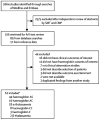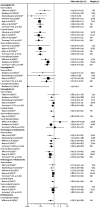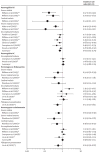Haemoglobinopathies and the clinical epidemiology of malaria: a systematic review and meta-analysis
- PMID: 22445352
- PMCID: PMC3404513
- DOI: 10.1016/S1473-3099(12)70055-5
Haemoglobinopathies and the clinical epidemiology of malaria: a systematic review and meta-analysis
Abstract
Background: Haemoglobinopathies can reduce the risk of malaria syndromes. We aimed to quantify the relation between different haemoglobin mutations and malaria protection to strengthen the foundation for translational studies of malaria pathogenesis and immunity.
Methods: We systematically searched the Medline and Embase databases for studies that estimated the risk of malaria in patients with and without haemoglobinopathies up to Sept 9, 2011, and identified additional studies from reference lists. We included studies that enrolled mainly children or pregnant women and had the following outcomes: Plasmodium falciparum severe malaria, uncomplicated malaria, asymptomatic parasitaemia, or pregnancy-associated malaria, and Plasmodium vivax malaria. Two reviewers identified studies independently, assessed quality of the studies, and extracted data. We produced odds ratios (ORs; 95% CIs) for case-control studies and incidence rate ratios (IRRs; 95% CIs) for prospective studies. We did the meta-analysis with a random-effects model when equivalent outcomes were reported in more than one study.
Findings: Of 62 identified studies, 44 reported data for haemoglobin AS, 19 for haemoglobin AC and CC, and 18 for α-thalassaemia. Meta-analysis of case-control studies showed a decreased risk of severe P. falciparum malaria in individuals with haemoglobin AS (OR 0·09, 95% CI 0·06-0·12), haemoglobin CC (0·27, 0·11-0·63), haemoglobin AC (0·83, 0·67-0·96), homozygous α-thalassaemia (0·63, 0·48-0·83), and heterozygous α-thalassaemia (0·83, 0·74-0·92). In meta-analysis of prospective trials only haemoglobin AS was consistently associated with protection from uncomplicated malaria (IRR 0·69, 95% CI 0·61-0·79); no haemoglobinopathies led to consistent protection from asymptomatic parasitaemia. Few clinical studies have investigated β-thalassaemia, haemoglobin E, P. vivax malaria, or pregnancy-associated malaria.
Interpretation: Haemoglobin AS, CC, and AC genotypes and homozygous and heterozygous α-thalassaemia provide significant protection from severe malaria syndromes, but these haemoglobinopathies differ substantially in the degree of protection provided and confer mild or no protection against uncomplicated malaria and asymptomatic parasitaemia. Through attenuation of severity of malaria, haemoglobinopathies could serve as a model for investigation of the mechanisms of malaria pathogenesis and immunity.
Funding: US National Institute of Allergy and Infectious Diseases.
Copyright © 2012 Elsevier Ltd. All rights reserved.
Conflict of interest statement
All authors declare that they have no conflicts of interest relevant to the subject of this manuscript.
Figures



Comment in
-
Balancing act: haemoglobinopathies and malaria.Lancet Infect Dis. 2012 Jun;12(6):427-8. doi: 10.1016/S1473-3099(12)70067-1. Epub 2012 Mar 23. Lancet Infect Dis. 2012. PMID: 22445353 No abstract available.
References
-
- Weatherall DJ, Provan AB. Red cells I: inherited anaemias. Lancet. 2000 Apr 1;355(9210):1169–1175. - PubMed
-
- Weatherall DJ. Genetic variation and susceptibility to infection: the red cell and malaria. Br J Haematol. 2008 May;141(3):276–286. - PubMed
-
- Fried M, Duffy PE. Adherence of Plasmodium falciparum to chondroitin sulfate A in the human placenta. Science. 1996 Jun 7;272(5267):1502–1504. - PubMed
-
- Fried M, Nosten F, Brockman A, Brabin BJ, Duffy PE. Maternal antibodies block malaria. Nature. 1998 Oct 29;395(6705):851–852. - PubMed
-
- Miller LH, Mason SJ, Clyde DF, McGinniss MH. The resistance factor to Plasmodium vivax in blacks. The Duffy-blood-group genotype, FyFy. N Engl J Med. 1976 Aug 5;295(6):302–304. - PubMed
Publication types
MeSH terms
Substances
Grants and funding
LinkOut - more resources
Full Text Sources
Medical
Research Materials

